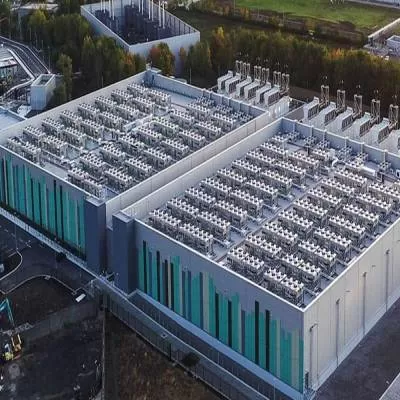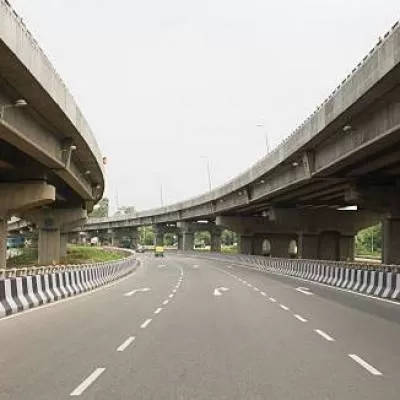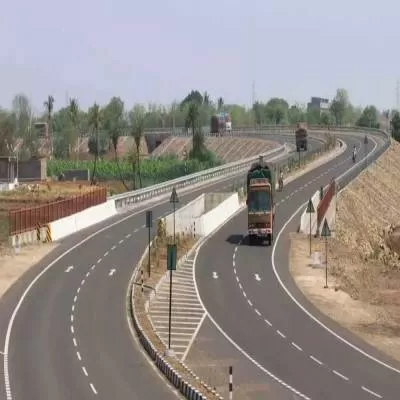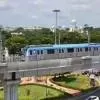- Home
- Infrastructure Transport
- ROADS & HIGHWAYS
- Flexible and Fast
Flexible and Fast
N Bhaskara Raju and Dr B Sivarma Sarma, FIE, MICE, Head Infrastructure & Head Research & Development, L&T Construction Research and Testing Centre, L&T - ECC, write on advanced materials for durable flexible pavements and speedy construction.
Today, India is poised for rapid development in infrastructure. For the target plans of 20 km per day as envisaged, it is essential for all stakeholders to have a holistic approach and revitalise many aspects in road construction, beginning from project sanctioning and contract terms in concessionaire agreements to freedom to implement new international design standards and construction practices, and post-maintenance practices. This article focuses on the construction of flexible pavements with application of advanced materials.
Scope for new materials and products
The typical crust of flexible pavement consists of four different layers as shown in Table 1.
Table 1
Crust for flexible pavement
| Crust from bottom | IRC conventional | New standards envisaged | Remarks on improvements |
| Sub-grade Fill | 2% to10% CBR | 2-50% CBR | Soil modification/stabilisation in sub-base |
| 2% to10% CBR | >10-50% CBR | ||
| GSB | Choice - six varieties | >20-100% CBR | Improvements in strength of base materials |
| WMM | Crushed rock | >100% CBR | Improvements in strength of base materials |
| DBM | Binder with 80/100, & 60/70 |
PG binders | Bituminous layers improvement depends upon environment, type of traffic and BC quality of comfort to road user. |
| BC | Binder 80/100,60 /70, 30 / 40, CRMB, etc |
PG binders |
Apart from this, IRC guidelines limit the use of the CBR (California bearing ratio) -based approach up to 150 MSA (millions
of standard axles). Hence, based on the present-day demand and explosion in traffic density and loading, the existing standards are required to be enhanced to address new challenges of increased traffic beyond 200 MSA and increased traffic loads. Overloading and poor construction practices will be detrimental to the progress anticipated. There are many alternatives in road construction.
Usually at sub-grade, the properties of earth vary along the length of the road. One can judiciously choose appropriate technology to convert the same soil for crust by modification. The modification enhances the CBR properties of soil. Similarly the modified GSB (granular sub-base) and WMM( water-bound mixed macadam) layers provide value addition by the addition of small quantities of binders. Enhanced properties in bituminous layers are possible with the use of PG (performance grade) binders. In the recent past, L&T-ECC has used a variety of special products as illustrated in Table 2 on a trial stretch for NHAI at Krishnagiri-Topurghat road.
Table 2
New Indian Standard to provide the scope for new materials
| Crust from bottom | New standards | New standards envisaged |
| Sub-grade | Up to 50% CBR | Fill usually should have CBR greater than the sub-grade. Sub-base should be adequate from drainage and strength considerations. Geo cells can be useful in weak soil. |
| Modified fill | ||
| Modified GSB | Upto 100% CBR | Geo cells, modified /stabilised soils, improved WMM of crushed rock with modifiers like lime, cement, fly ash, slag, etc, will enhance the strength properties of the base. |
| Modified WMM | >100% CBR | |
| Mod. binders DBM | Any type of binder |
Improved binders (performance grade binders) provide better structural performance of bituminous macadam and reduce maintenance issues. Many polymers are available and can be chosen based on environment and load criteria |
| Mod. binders BC | Any type of binder |
Initiatives with new products
L&T has taken the lead in application of new products on an experimental basis. Table 3 highlights a few of these initiatives.
Table 3
L&T's initiatives with new materials in pavements
| Highway section | Year | New product application |
| NH7 Krishnagiri-Thopurghat | 2008 | First alternate crust based on mechanistic approach with new materials |
| NH8a Vadodara-Bharuch | 2007 | Lime stabilisation and recycled material utilisation |
| NH8 Jaipur-Kishangarh | 2005 | Plastomeric polymer-modified PMB utilisation for BC |
| NH5 Chennai-Tada | 2004 | First elastomeric polymer-modified PMB utilisation for BC |
| NH47 Coimbatore bypass | 1998 | First CRMB application |
| SH10 Sambalpur-Rourkela expressway |
1990 | IRC specification and mechanised tack coat application |
Improvements to promote speed of construction
The designer should have adequate freedom and knowledge on materials to optimise the crust thickness based on the application of new materials.
The concessionaire agreement should provide scope for value addition and the benefits should be equally shared by the contractor and owner.
There should be adequate freedom to take proactive decisions and promote value addition in the total project to reduce the cost and improve the speed of construction within reasonable financial budgets.
The lifecycle cost including maintenance has to be looked into in the application of new products and technologies.
The concept of partnering in National Highway construction will help bring in smooth operations and achieve excellent performance.
From Figure 1, it is evident that there is a lot of scope for improvement, both in the design and construction process. By choosing performance-based materials, crust thickness can be optimised and the road can be speedily constructed. The benefits of new technology will be higher for weak soil sub-grades and poor quality of aggregates availability.
Conclusions
There exist many international standards and innumerable experiences with different products within the country and abroad to improve road construction. India needs to quickly adopt the best technologies to provide the best comfort to the user and enable efficient green road construction practices.
This presentation was made by the authors at ASAPP Media's 2nd National Conference on India Roads 2010.
N Bhaskara Raju and Dr B Sivarma Sarma, FIE, MICE, Head Infrastructure & Head Research & Development, L&T Construction Research and Testing Centre, L&T - ECC, write on advanced materials for durable flexible pavements and speedy construction. Today, India is poised for rapid development in infrastructure. For the target plans of 20 km per day as envisaged, it is essential for all stakeholders to have a holistic approach and revitalise many aspects in road construction, beginning from project sanctioning and contract terms in concessionaire agreements to freedom to implement new international design standards and construction practices, and post-maintenance practices. This article focuses on the construction of flexible pavements with application of advanced materials. Scope for new materials and products The typical crust of flexible pavement consists of four different layers as shown in Table 1. Table 1 Crust for flexible pavement Crust from bottom IRC conventional New standards envisaged Remarks on improvements Sub-grade Fill 2% to10% CBR 2-50% CBR Soil modification/stabilisation in sub-base 2% to10% CBR >10-50% CBR GSB Choice - six varieties >20-100% CBR Improvements in strength of base materials WMM Crushed rock >100% CBR Improvements in strength of base materials DBM Binder with 80/100, &60/70 PG binders Bituminous layers improvement dependsupon environment, type of traffic andBC quality of comfort to road user. BC Binder 80/100,60 /70,30 / 40, CRMB, etc PG binders Apart from this, IRC guidelines limit the use of the CBR (California bearing ratio) -based approach up to 150 MSA (millions of standard axles). Hence, based on the present-day demand and explosion in traffic density and loading, the existing standards are required to be enhanced to address new challenges of increased traffic beyond 200 MSA and increased traffic loads. Overloading and poor construction practices will be detrimental to the progress anticipated. There are many alternatives in road construction. Usually at sub-grade, the properties of earth vary along the length of the road. One can judiciously choose appropriate technology to convert the same soil for crust by modification. The modification enhances the CBR properties of soil. Similarly the modified GSB (granular sub-base) and WMM( water-bound mixed macadam) layers provide value addition by the addition of small quantities of binders. Enhanced properties in bituminous layers are possible with the use of PG (performance grade) binders. In the recent past, L&T-ECC has used a variety of special products as illustrated in Table 2 on a trial stretch for NHAI at Krishnagiri-Topurghat road. Table 2 New Indian Standard to provide the scope for new materials Crust from bottom New standards New standards envisaged Sub-grade Up to 50% CBR Fill usually should have CBRgreater than the sub-grade.Sub-base should be adequatefrom drainage and strengthconsiderations. Geo cells canbe useful in weak soil. Modified fill Modified GSB Upto 100% CBR Geo cells, modified /stabilisedsoils, improved WMM ofcrushed rock with modifiers likelime, cement, fly ash, slag, etc,will enhance the strength propertiesof the base. Modified WMM >100% CBR Mod. binders DBM Any type ofbinder Improved binders (performancegrade binders) provide betterstructural performance of bituminousmacadam and reducemaintenance issues. Many polymersare available and can bechosen based on environmentand load criteria Mod. binders BC Any type ofbinder Initiatives with new products L&T has taken the lead in application of new products on an experimental basis. Table 3 highlights a few of these initiatives. Table 3 L&T's initiatives with new materials in pavements Highway section Year New product application NH7 Krishnagiri-Thopurghat 2008 First alternate crust based on mechanistic approach with new materials NH8a Vadodara-Bharuch 2007 Lime stabilisation and recycled material utilisation NH8 Jaipur-Kishangarh 2005 Plastomeric polymer-modified PMB utilisation for BC NH5 Chennai-Tada 2004 First elastomeric polymer-modified PMB utilisation for BC NH47 Coimbatore bypass 1998 First CRMB application SH10 Sambalpur-Rourkelaexpressway 1990 IRC specification and mechanised tack coat application Improvements to promote speed of construction The designer should have adequate freedom and knowledge on materials to optimise the crust thickness based on the application of new materials. The concessionaire agreement should provide scope for value addition and the benefits should be equally shared by the contractor and owner. There should be adequate freedom to take proactive decisions and promote value addition in the total project to reduce the cost and improve the speed of construction within reasonable financial budgets. The lifecycle cost including maintenance has to be looked into in the application of new products and technologies. The concept of partnering in National Highway construction will help bring in smooth operations and achieve excellent performance. From Figure 1, it is evident that there is a lot of scope for improvement, both in the design and construction process. By choosing performance-based materials, crust thickness can be optimised and the road can be speedily constructed. The benefits of new technology will be higher for weak soil sub-grades and poor quality of aggregates availability. Conclusions There exist many international standards and innumerable experiences with different products within the country and abroad to improve road construction. India needs to quickly adopt the best technologies to provide the best comfort to the user and enable efficient green road construction practices. This presentation was made by the authors at ASAPP Media's 2nd National Conference on India Roads 2010.























